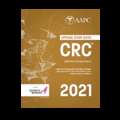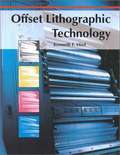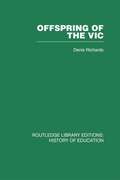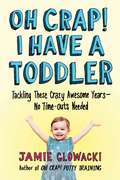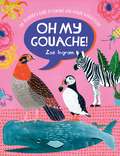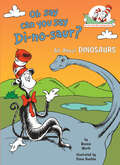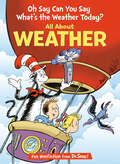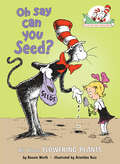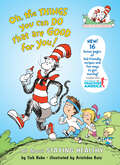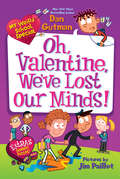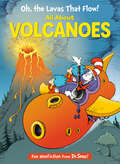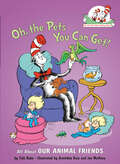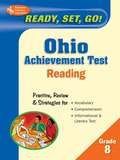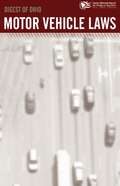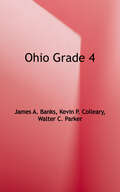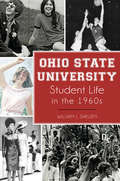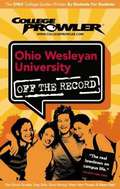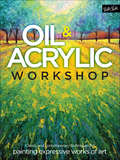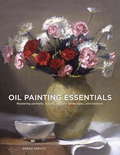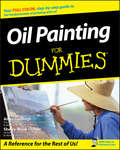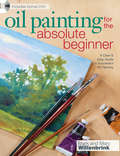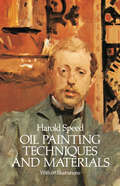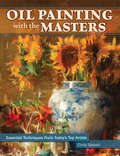- Table View
- List View
Official Study Guide CRC™ Certification
by Brian BoyceAAPC's CRC® Certification Study guide is specifically designed to help individuals prepare for the CRC® exam. The chapters will guide through a review of ICD-10-CM documentation and coding, risk adjustment models, predictive modeling and quality of care, how risk adjustment relates to medical financial matters, clinical documentation barriers, and frequently coded conditions in risk adjustment models. The study guide covers all the content sections found on the exam and will also provide with testing tips for taking the AAPC's CRC® exam. Practical Examples, Testing Techniques for CRC® exam, Questions designed to mimic the CRC® certification exam, Each chapter includes ten review questions geared to test important coding concepts, 50 Test your Knowledge questions with answers and rationales are the key features of this Study Guide.
Offset Lithographic Technology
by Kenneth F. HirdOffset Lithographic Technology provides extensive coverage of state-of-the-art electronic applications in all areas of printing.
Offspring of the Vic: A History of Morley College
by Denis RichardsOriginally published in 1958.The history of Morley College provides an illuminating case-history of the growth and spread of adult education in the second half of the nineteenth and early years of the twentieth centuries. Morley College is unique in that it was one of the first of such institutions to proclaim and inculcate absolute sex and class equality. It has always been guided by democratic principles in the sense that the students have been encouraged to play a definite part in the administration of the college – an ethos which continues to this day.
Oh Crap! I Have a Toddler: Tackling These Crazy Awesome Years—No Time-outs Needed (Oh Crap Parenting #2)
by Jamie GlowackiReal-world, from-the-trenches toddler parenting advice from the author of the bestselling Oh Crap! Potty Training. Toddlers—commonly defined as children aged between two and five years old—can be a horribly misunderstood bunch. What most parents view as bad behavior is in fact just curious behavior. Toddlerdom is the age of individuation, seeking control, and above all, learning how the world works. But this misunderstanding between parents and child can lead to power struggles, tantrums, and even diminished growth and creativity. The recent push of early intellectualism coupled with a desire to “make childhood magical” has created a strange paradox—we have three-year-olds with math and Mandarin tutors who don’t know how to dress themselves and are sitting in their own poop. We are pushing the toddler mind beyond its limit but simultaneously keeping them far below their own natural capabilities. In the frank, funny, and totally authentic Oh Crap! I Have a Toddler, social worker Jamie Glowacki helps parents work through what she considers the five essential components of raising toddlers: —Engaging the toddler mind —Working with the toddler body —Understanding and dealing with the toddler behavior —Creating a good toddler environment —You, the parent Oh Crap! I Have a Toddler is about doing more with less—and bringing real childhood back from the brink of over-scheduled, over-stimulated, helicopter parenting. With her signature down-and-dirty, friend-to-friend advice, Jamie is here to help you experience the joy of parenting again and giving your child—and yourself—the freedom to let them grow at their own pace and become who they are.
Oh My Gouache!: The Beginner's Guide to Painting with Opaque Watercolour
by Zoë IngramWelcome to the wonderful world of painting with gouache, with the creative guidance of popular artist and illustrator Zoe Ingram. In this comprehensive beginner's guide, Zoe shares everything she possibly can about getting started with gouache painting. Why gouache? Because this exciting paint medium creates opaque effects making it more vibrant and graphic than traditional watercolours, meaning you can layer it, paint on dark backgrounds and much more. Gouache is one of the easiest of paint mediums to use. It's very forgiving and fun to use and is also versatile. Gouache paint can mimic watercolour and can give the opacity of oil paint if used with less water. You can use it to paint large, smooth, flat blocks of background colour and the finest lines and details. Gouache paint also dries quickly too, which is a big bonus! Starting at the very start, Zoe takes you through the basics and explains what tools and materials you'll need, then explores a wide range of techniques and finally, there are a host of fun and vibrant step-by-step projects that you can follow along with or use as a springboard for your own ideas. Zoe Ingram's distinctive art makes this book a visual treat, as she shows you how she paints a variety of subjects, from birds and bugs, to flowers and foliage, to abstract collages, hand lettering and patterns. Along the way you'll learn about colour theory, colour mixing, sketching, washes, mark making, line work, overlaying, working on dark backgrounds, how to get crisp edges, how to add details, different approaches to collage and even how to digitise your work so that you can create repeat patterns and custom prints. In the projects section you can follow along step-by-step as Zoe paints a very handsome pheasant, a funky beetle pattern, a trendy houseplant, colourful caterpillars, bright butterflies, jumbled geometric patterns, a striking owl, pretty florals, creative lettering, a curious cat and a free-flow abstract floral piece ; after which there will be no stopping you! Beautifully illustrated, expertly explained and a riot of colour, this book will kickstart your love affair with gouache, so all that's left is deciding how to pronounce it... "gooash"..."gwash"..."goo-uhsh"?!
Oh Say Can You Say Di-no-saur? All About Dinosaurs: All About Dinosaurs (The Cat in the Hat's Learning Library)
by Bonnie WorthLaugh and learn with fun facts about dinosaurs like Tyrannosaurus rex, Apatosaurus, Triceratops, and more—all told in Dr. Seuss&’s beloved rhyming style and starring The Cat in the Hat! &“I&’m the Cat in the Hat (you have met me before). Today I will speak of the great dinosaur!&” The Cat in the Hat&’s Learning Library series combines beloved characters, engaging rhymes, and Seussian illustrations to introduce children to non-fiction topics from the real world! In this positively prehistoric adventure, readers will learn: • how fossils are formed and found• what different dinosaurs ate• how to pronounce tricky dinosaur names• and much more! Perfect for story time and for the youngest readers, Oh Say Can You Say Di-no-saur also includes an index, glossary, and suggestions for further learning. Look for more books in the Cat in the Hat&’s Learning Library series!Cows Can Moo! Can You? All About FarmsHark! A Shark! All About SharksIf I Ran the Dog Show: All About DogsOn Beyond Bugs! All About InsectsOne Vote Two Votes I Vote You VoteThere&’s No Place Like Space: All About Our Solar SystemWho Hatches the Egg? All About EggsWhy Oh Why Are Deserts Dry? All About DesertsWish for a Fish: All About Sea Creatures
Oh Say Can You Say What's the Weather Today? All About Weather: All About Weather (The Cat in the Hat's Learning Library)
by Tish RabeLaugh and learn with fun facts about the sun, thunderstorms, snowflakes, and more—all told in Dr. Seuss&’s beloved rhyming style and starring the Cat in the Hat! &“You see, weather keeps changing, but one thing we know. It makes life exciting wherever you go.&” The Cat in the Hat&’s Learning Library series combines beloved characters, engaging rhymes, and Seussian illustrations to introduce children to non-fiction topics from the real world! Look up in the sky and learn: • how to read a weather map• what the water cycle is• how meteorologists forecast the weather• and much more! Perfect for story time and for the youngest readers, Oh Say Can You Say What's the Weather Today? All About Weather also includes an index, glossary, and suggestions for further learning. Look for more books in the Cat in the Hat&’s Learning Library series!If I Ran the Horse Show: All About HorsesClam-I-Am! All About the BeachMiles and Miles of Reptiles: All About ReptilesA Whale of a Tale! All About Porpoises, Dolphins, and WhalesSafari, So Good! All About African WildlifeThere's a Map on My Lap! All About MapsOh, the Lavas That Flow! All About VolcanoesOut of Sight Till Tonight! All About Nocturnal AnimalsWhat Cat Is That? All About CatsOnce upon a Mastodon: All About Prehistoric MammalsThe Cat on the Mat: All About Mindfulness
Oh Say Can You Seed? All About Flowering Plants: All About Flowering Plants (The Cat in the Hat's Learning Library)
by Bonnie WorthLaugh and learn with fun facts about flowers, plants, fruit, and more—all told in Dr. Seuss&’s beloved rhyming style and starring the Cat in the Hat! &“I&’m the Cat in the Hat, and I think that you need to come take a look at this thing called a seed.&” The Cat in the Hat&’s Learning Library series combines beloved characters, engaging rhymes, and Seussian illustrations to introduce children to non-fiction topics from the real world! Grow your brain with fun facts about flowering plants and learn: how they all start out as a seedhow they make their own food inside their leaveshow bees help spread the pollen flowers need to produce fruitand much more!Perfect for story time and for the youngest readers, Oh Say Can You Seed? All About Flowering Plants also includes an index, glossary, and suggestions for further learning. Look for more books in the Cat in the Hat&’s Learning Library series!High? Low? Where Did It Go? All About Animal CamouflageIs a Camel a Mammal? All About MammalsThe 100 Hats of the Cat in the Hat: A Celebration of the 100th Day of SchoolA Great Day for Pup: All About Wild BabiesWould You Rather Be a Pollywog? All About Pond LifeHappy Pi Day to You! All About Measuring CirclesI Can Name 50 Trees Today! All About TreesFine Feathered Friends: All About BirdsMy, Oh My--A Butterfly! All About ButterfliesInside Your Outside! All About the Human BodyIce is Nice! All About the North and South Poles
Oh, The Things You Can Do That Are Good for You: All About Staying Healthy (Cat in the Hat's Learning Library)
by Tish RabeThe Cat in the Hat joins forces with the Partnership for a Healthier America!In this newly revised editiion—with 16 pages of bonus materials—the Cat in the Hat takes young readers to a Seussian Spa where they learn the basics of healthy living. Updated with the assistance of the Partnership for a Healthier America, the Cat explains the importance of eating right (based on the latest USDA MyPlate recommendations); staying active; getting enough sleep; handwashing; brushing and flossing; wearing protective gear when playing sports--even the best way to sneeze when you don't have a tissue handy! The 16 pages of newly added backmatter include simple, fun suggestions for children to increase their activity thoughout the day, plus 8 kid-friendly, healthy recipes for parents to prepare for their hungry broods. An ideal choice for supporting Common Core Standards and fans of the hit PBS Kids television show The Cat in the Hat Knows a Lot About That!—this is a book that supports healthy bodies AND healthy minds!
Oh, Valentine, We've Lost Our Minds! (My Weird School Special)
by Dan Gutman Jim PaillotA.J. and the gang from My Weird School star in this series of after-school, holiday-themed chapter books featuring all-new hilarious stories and thirty-two pages of games, puzzles, and more.It's the week of Valentine's Day, and A.J.'s class is getting a foreign exchange student! His name is Pierre, and he's from France. But what happens when Pierre challenges A.J. to a duel (or at least a thumb war) over Andrea? One thing's for sure: when L-O-V-E comes to Ella Mentry, it spells the weirdest Valentine's Day story in the history of the world!Bestselling author Dan Gutman brings his kid-friendly sense of humor to this all-new series of holiday adventures. With My Weird School checklists and trivia plus tons of Valentine-themed facts and puzzles, this is one weird Valentine special you don't want to miss!
Oh, the Lavas That Flow! All About Volcanoes (The Cat in the Hat's Learning Library)
by Todd TarpleyLaugh and learn with fun facts about hot lava, ash clouds, volcanos, and more—all told in Dr. Seuss&’s beloved rhyming style and starring the Cat in the Hat!&“I&’m the Cat in the Hat, and I&’m here to explain-o some marvelous facts all about the volcano!&” The Cat in the Hat&’s Learning Library series combines beloved characters, engaging rhymes, and Seussian illustrations to introduce children to non-fiction topics from the real world! Erupt with laughter while you discover:• how most volcanoes are underwater• what the difference between lava and magma is• how volcanoes help create rain and new land• and much more!Perfect for story time and for the youngest readers, Oh, the Lavas That Flow! All About Volcanoes also includes an index, glossary, and suggestions for further learning. Look for more books in the Cat in the Hat&’s Learning Library series!If I Ran the Horse Show: All About HorsesClam-I-Am! All About the BeachMiles and Miles of Reptiles: All About ReptilesA Whale of a Tale! All About Porpoises, Dolphins, and WhalesSafari, So Good! All About African WildlifeThere's a Map on My Lap! All About MapsOut of Sight Till Tonight! All About Nocturnal AnimalsWhat Cat Is That? All About CatsOnce upon a Mastodon: All About Prehistoric MammalsOh Say Can You Say What's the Weather Today? All About WeatherThe Cat on the Mat: All About Mindfulness
Oh, the Pets You Can Get!: All About Our Animal Friends (Cat in the Hat's Learning Library)
by Tish RabeThe Cat and Co. take off to the faraway land of Gerpletz where they know quite a lot about caring for pets—especially cats, dogs, guinea pigs, birds, and bunnies! From the food, shelter, exercise, and medical care they need to the love and companionship they crave, the Cat teaches beginning readers how to keep their pets (and themselves!) healthy, safe, and happy.
Ohio Achievement Test, Grade 8 Reading (Ohio Achievement Test Preparation Ser.)
by The Editors of REA Dana PassanantiREA's Grade 8 Ohio Achievement Test - Reading - Test Prep! Fully aligned with the Academic Content Standards of the Ohio Department of Education Are you prepared to excel on this state high-stakes assessment exam? * Take the diagnostic Pretest and find out what you know and what you should know * Use REA's advice and tips to ready yourself for proper study and practice Sharpen your knowledge and skills * The book's full subject review refreshes knowledge and covers all four standards on the official exam: Acquisition of Vocabulary, Reading Process, Informational Text, and Literary Text * Smart and friendly lessons reinforce necessary skills * Key tutorials enhance specific abilities needed on the test * Targeted drills increase comprehension and help organize study * Color icons and graphics highlight important concepts and tasks Practice for real * Create the closest experience to test-day conditions with a full-length practice Posttest * Chart your progress with detailed explanations of each answer * Boost confidence with test-taking strategies and focused drills Ideal for Classroom, Family, or Solo Test Preparation! REA has helped generations of students study smart and excel on the important tests. REA's study guides for state-required exams are teacher-recommended and written by experts who have mastered the test.
Ohio Digest of Motor Vehicle Laws
by Ohio Department of Public SafetyOhio Digest of Motor Vehicle Laws
Ohio Grade 4
by James A. Banks Kevin P. Colleary Walter C. ParkerThis book is organized to help you understand and apply social studies content and skills as you read. -Unit Opener and People Who Made a Difference pages introduce you to the people and places in the unit. - Chapter Opener pages introduce you to the time and place of events you will read about. - Lesson Opener pages prepare you before you read. - Lesson Review pages test your understanding of the lesson. -Reading Skills pages help you understand social studies content. - Biographies and Primary Sources bring the past alive. - Citizenship pages show real-life participation in democracy. -Readers' Theater and Literature bring Ohio history alive.
Ohio State University Student Life in the 1960s
by William J. ShkurtiStudents entering Ohio State University in the 1960s enjoyed a period of unprecedented prosperity and expanding freedom for young people. They partied in togas and twisted the night away. They gathered at Larry's, the Bergs and the BBF. They cheered on a national championship football team and grooved to folk singers, folk rockers and acid rockers, many of whom visited campus. They donned bold and sometimes outrageous new styles in clothing and bonded together as part of a cultural revolution unmatched before or since. Join author and OSU alum William J. Shkurti for a magical mystery tour through a decade when being young and in college meant you had a ticket to ride.
Ohio Wesleyan University (College Prowler)
by Evan Matthew ReasNo university affiliations. No half-truths. No out-of-touch authors who haven't been in school for decades. A class project turned company, College Prowler produces guidebooks that are written by actual college students and cover the things students really want to know. Unlike other guides that jam everything into a five-pound book and devote only two pages to each college, our single-school guidebooks give students only the schools they want and all the information they need. From academics and diversity to nightlife and sports, we let the students tell it how it is. In addition to editorial reviews and grades for 20 different topics, more than 80 percent of each guide is composed of actual student reviews of their school. Whether readers are looking for "Best and Worst" lists, "Did You Knows?" or traditions, College Prowler guides have it all. Our books are the only place for local slang, urban legends, and tips on the best places to find a date, study, or grab a bite to eat.
Ohio in the United States
by Zimmer Jarrett KilloranOhio in the United States will help you master Ohio's Fourth Grade Learning Standards in social studies. In the activities in this book, you will learn about the geography of Ohio, the main events that led to the settling of Ohio, and some of the challenges the people of Ohio have faced since achieving statehood. You will also learn about Ohio's diverse ethnic heritage and the importance of respecting the traditions and achievements of others. You are about to set off on an exciting journey in which you will travel through 28 activities. Each activity has been designed to provide you with an opportunity to cooperate, discuss, brainstorm, debate, research, and learn what you need for passing the Fourth Grade Ohio Achievement Test in Social Studies.
Oil & Acrylic Workshop: Classic and Contemporary Techniques for Painting Expressive Works of Art
by Kimberly Adams Bridget Skanski-Such Yiqi LiCreate colorful works of art using a variety of painting techniques with this guide featuring classic tools and modern twists.In Oil & Acrylic Workshop, impressionist painter Kimberly Adams teaches you to harness the creative power of both traditional and contemporary painting tools to create textured, vibrant, and colorful works of art. Whether you're an aspiring or established artist, you will relish setting aside the paintbrush in exchange for the palette knife, sponges, and even your fingers! This book comes packed with techniques for working with oil and acrylic, as well as color theory and approachable step-by-step projects. Featured projects explore the art of creating landscapes, mastering animals, painting delicate flowers, and much more.
Oil Painting Essentials: Mastering Portraits, Figures, Still Lifes, Landscapes, and Interiors
by Gregg KreutzAn essential guide to the oil painting techniques that will allow artists to master a variety of subjects, including figures, portraits, still life, landscapes, and interiors.Many painters limit themselves to one type of subject matter, but in Oil Painting Essentials, artist and art instructor Gregg Kreutz shows how a multi-genre approach can dramatically improve your painting skills. Arranged by category, each chapter covers both the essentials specific to that subject matter and those that apply to all genres. Through step-by-step lessons and examples from his own oil paintings, Kreutz shows how you can strengthen your skillset for one genre by painting in another. This comprehensive exploration of the conceptual and practical issues behind oil painting provides all of the tools and encouragement you need to successfully take on any type of oil painting.From the Trade Paperback edition.
Oil Painting For Dummies
by Sherry Stone Clifton Anita Marie GiddingsNobody ever said that oil painting was easy. But it gets much easier and a lot more fun when you follow a step-by-step approach that starts you off on the right foot, helps you build your skills one at a time, and gives you plenty of exercises to develop your craft. That's what you'll find in Oil Painting For Dummies.Completely free of arty jargon, this full-color guide has all the hands-on instruction you need to master the basics. You'll see how to plan a painting, build an image in layers, mix colors, and create stunning compositions. You'll also find everything you need to know about oil paints, solvents, and pigments; brushes, palettes, and painting surfaces; and how to keep costs down at the art supply store. Discover how to:Choose the right suppliesSet up your studio and care for your equipmentHandle your materials safelyDevelop your design and composition skillsMake practice sketches and studiesUse broken stroke, dry brush, glazing, scraffito and other brush strokesTry out different compositionsMix any color you wantSimplify tricky still-life subjectsPaint landscapes and common objects out doorsPaint portraits and the human formComplete with handy color chart, basic materials list, and a very useful viewing square, Oil Painting For Dummies is the fun and easy way to discover your inner artist!
Oil Painting For The Absolute Beginner: A Clear & Easy Guide to Successful Oil Painting (Art for the Absolute Beginner)
by Mark WillenbrinkThe quick-start guide to great results! Oil painting doesn't have to be rocket science, although some books on the subject make it seem that way. Filled with encouraging, easy-to-follow instruction, Oil Painting for the Absolute Beginner is a no-fear, no-experience-required guide to enjoyable painting and happy results. Focusing on the needs of the first-time painter, this book covers everything from selecting brushes and setting up your palette to key principles of color and composition, presented in a way that moves you confidently from first strokes to finished paintings. Mini demonstrations break down fundamental painting techniques in a clear, common sense way 12 step-by-step painting projects progress from simple landscapes, still life and flower paintings to more challenging subjects, such as animals, seascapes and portraits The bonus DVD-workshop features the author creating two paintings from start to finish You'll learn tricks for keeping the greens in your landscapes looking fresh, advantages to working with water-soluble oil paints, simple tips for dynamic compositions and other expert advice to make your introduction to oil painting the beginning of a beautiful friendship.
Oil Painting Techniques and Materials
by Harold Speed"In any exhibition of amateur work . . . it is not at all unusual to find many charming water-colour drawings, but . . . it is very rarely that the work in the oil medium is anything but dull, dead, and lacking in all vitality and charm." -- Harold SpeedSuch provocative assertions are characteristic of this stimulating and informative guide, written in a highly personal and unique style by a noted painter and teacher. Brimming with pertinent insights into the technical aspects and painting in oils, it is also designed to help students perfect powers of observation and expression.Harold Speed has distilled years of painting and pedagogical experience into an expert instructional program covering painting technique, painting from life, materials (paints, varnishes, oils and mediums, grounds, etc.), a painter's training, and more. Especially instructive is his extensive and perceptive discussion of form, tone, and color, and a fascinating series of detailed "Notes" analyzing the painting styles of Velasquez, Reynolds, Gainsborough, Franz Hals, and Rembrandt.Nearly 70 photographs and drawings illustrate the text, among them prehistoric cave paintings, diagrams of tonal values, stages of portrait painting, and reproductions of masterpieces by Giotto, Vermeer, Ingres, Rembrandt, Titian, Reynolds, Gainsborough, Hals, Giorgione, Poussin, Corot, Veronese, and other luminaries. In addition to these pictorial pleasures, the author further leavens the lessons with thought-provoking opinion.Clear, cogent, and down-to-earth, this time-honored handbook will especially interest serious amateurs studying the technical aspects of oil painting, but its rich insight into the mind and methods of the artist will enlighten and intrigue any art lover.
Oil Painting with the Masters: Essential Techniques from Today's Top Artists
by Cindy SalaskiMaster the art of oil painting with instruction on key topics and techniques such as materials, observation, references, forms, composition, color palettes, mixing colors, underpainting, working in layers, light effects, painting on location, textures and more from ten contributors, including beautiful gallery images of finished works.You will enjoy producing better artworks and getting professional-looking results by studying the methods of today's experts, such as Laurie Kersey, Camille Przewodek, Albert Handell, Kevin MacPherson, Phil Starke, Marc Hanson and more. These award-winning contributors have exhibited around the world and have distinguished publishing histories with F+W Media and others.
